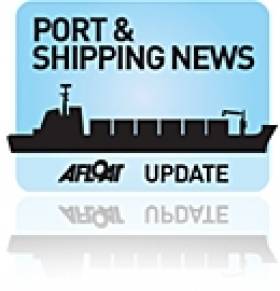Displaying items by tag: Fastnet Shipping
Fastnet Shipping Add New Wind-Farm Cat Support-Survey Vessel
#NewWindCat- Waterford based Fastnet Shipping Limited has added a new 22m windfarm and survey support catamaran to its fleet of marine plant hire, writes Jehan Ashmore.
The craft which has space to seat up to 27 personnel will be used to transferring construction and crew service teams for the offshore wind-farm /turbine transfer market.
As previously reported on Afloat.ie, the company since 2010 has entered this sector in UK waters, when they commissioned a quartet of multi-purpose high-speed craft wind-farm support vessels (WFSV) for the charter market.
The introduction of this fifth and larger WFSV will see the 24 knots maximum capable Fastnet Rock able to operate up to 200 nautical miles.
For further vessel specifications of the Panamanian flagged craft click HERE.
In addition to the wind-farm support vessels, Fastnet Shipping operate and charter out vessels involved in dredging contracts, harbour and coastal towage and provide offshore logistics support services.
Container Ship Successfully Refloated in Waterford Harbour
In attendance was Bargarth, a UK-flagged tug based in Waterford and operated by Fastnet Shipping. The twin Voith & fire-fighting tug made a special appearance during the Tall Ships Races Parade of Sail on 3 July, when she put on a celebratory water-display off Dunmore East.
Samskip Eandeavour is capable of handling 812 twenty-foot equivalent containers (TEU). She was completed only this year by Damen Gorinchem Scheepswerf B.V. Foxtol in the Netherlands. The vessel is operated by an Icelandic company, Samskip which provides several container feeder-liner services between Rotterdam / Zeebrugge with Belfast, Dublin, Cork and Waterford.
After unloading and loading at Belview the 140m vessel is scheduled to dock in the Port of Cork tomorrow at the Tivoli Container Terminal before returning to Europe.
Dunmore East Bids TallShips Farewell
As the Russian 'A' class Mir passed the LE Aoife off Dunmore East in mid-morning, the largest tall ship of the festival headed the start of the Parade of Sail, writes Jehan Ashmore.
Crowds left their cars in fields outside Dunmore East and descended into the harbour and surrounding headlands to witness the highlight of the four-day festival. Adding to the scene were the numerous leisure-craft, yachts and intrepid kayakers that gathered to greet the procession which took some two hours to pass the fishing harbour.
No sooner had the fully-rigged ship Mir had slipped beyond the anchored naval vessel that the gaff schooner Johanna Lucretia, under full sail came closer into view. She was closely followed by the Ocean Youth Trust Scotland's Bermudan cutter Alba Explorer.

The Russian 'A' class Mir passing the LE Aoife off Dunmore East. Photo: Jehan Ashmore
Of all the 45 tallships participating the Columbian Navy's barque ARC Gloria presented the most colourful entrant. She proudly flew a large horizontal tricolor of yellow, blue and red representing the South American nation.
When it came to the turn of the Europa to pass the LE Aoife, the tug Bargarth gave a wonderful send-off with the traditional display of water jets shooting sky-high, nearly reaching the top of the three-masted barque.
Marking the tail-end of the parade was the Jubilee Sailing Trust's Lord Nelson, another barque that departed the estuary with the Hook Head Lighthouse forming a majestic backdrop.
At this stage several of the large tallships could be seen on the far horizon in preperation to the start of the first race leg of this years Tall Ships Races....next port of call Greenock!
- Waterford
- ship
- Dunmore East
- Lord Nelson
- Waterford Estuary
- LE Aoife
- Sail Training International
- Jubilee Sailing Trust
- Tug
- Hook Head
- Tall
- JOHANNA LUCRETIA
- TallShips
- Waterford Harbour
- JST
- Europa
- Fullyrigged ship
- STI
- ARC Gloria
- Hook Head Lighthouse
- Mir
- Gaff schooner
- Ocean Youth Trust Scotland
- Bermudan cutter
- Alba Explorer
- Columbian Navy barque
- Bargarth
- Fastnet Shipping


























































